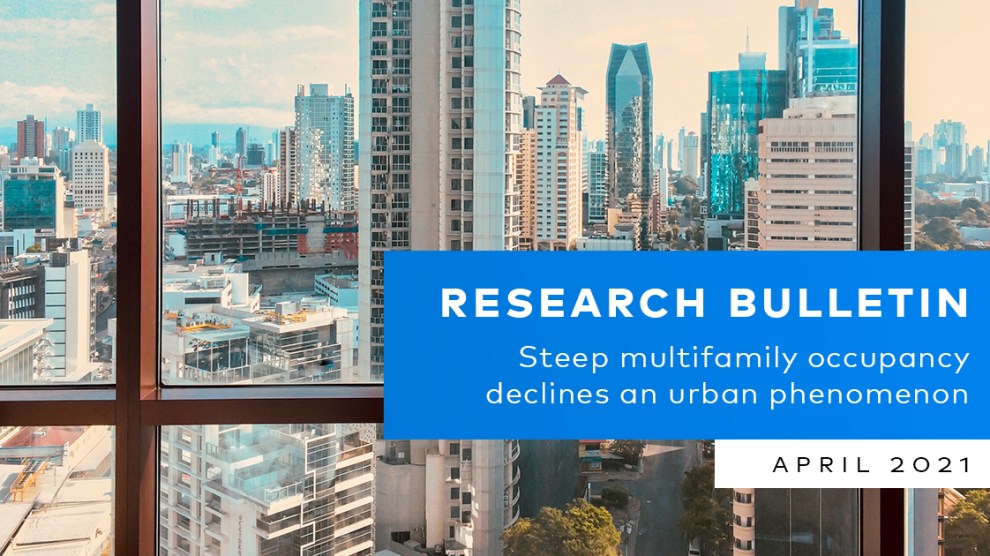The fallout from COVID-19 has produced very little distressed real estate to date. Multifamily occupancy rates have declined only slightly on the national level, with the biggest declines coming in high-cost Gateway metros.
Gauging the potential for distress, however, requires a property-level examination. To that end, we analyzed more than 78,000 properties in the Yardi Matrix database to determine how many had occupancy rates decrease by 5% or 10% or more in the 12 months following the start of the pandemic. Then we compared results to our metro rent forecasts to determine how long it may take to recover lost revenue.
The results found a large bifurcation in market performance and recovery period. Roughly one out of every 14 multifamily properties (7.3%) in the U.S. have seen occupancy rates drop by 5% or more over the 12 months ending February 2021 while roughly one in 40 (1.8%) saw occupancy rates drop by 10% or more.
The impact is overwhelmingly concentrated in a handful of urban submarkets – particularly Manhattan, San Francisco, Chicago, and Los Angeles – that could take years to get back to pre-COVID rent levels. New York City had by far the most properties with serious occupancy decreases. Some 857 multifamily properties (32.6% of the total in the city) saw occupancy decrease by 5% while 251 properties (9.8% of the total) saw occupancies decline by 10% or more.
Other metros with substantial property-level issues include: San Jose, where 182 properties (25.1% of the total) saw a 5% or more drop in occupancy and 54 properties (7.4%) a drop of 10% or more; Los Angeles, with 485 properties (21.8%) with a 5% or more drop and 92 (4.2%) with 10% or more; Chicago, which had 396 properties (20.9%) with a 5% or more drop and 112 properties (5.9%) with 10% or more; and San Francisco, which had 360 properties (19.4%) with a 5% or more decline and 125 properties (6.7%) with 10% or more.
Even the metro-level numbers fail to do justice to the concentration of the problem. Within each of these metros, urban submarkets had substantially worse performance. In New York City, for example, occupancy decreases were largely confined to Manhattan, where a whopping 830 properties, or 47.8% of all apartment buildings, experienced a 5% or more decline in occupancy rates and 13.6% declined by 10% or more. Meanwhile, only 4.4% of properties in Queens and 2.0% of properties in Brooklyn saw occupancy rates drop as much as 5%.
The story was similar, if not as dire, in other Gateway metros. In the San Francisco Peninsula, 35.1% of properties had a 5% decrease in occupancy rates compared to only 6.5% in the East Bay. Some 34.5% of properties in Urban Chicago saw occupancy rates increase by 5%, while the rate was 2.5% in Suburban Chicago. 32.5% of properties in Urban Los Angeles had an occupancy rate increase of 5% or more compared to only 2.6% in the Eastern County.
While the data demonstrates the troubles facing some segments of the market, the industry can take solace in the finding that the poor performance in demand and occupancy is limited. The results show that the amount of distress anticipated by some is likely to remain limited, and whatever does occur will almost certainly be concentrated in high-cost Gateway centers that will have a much bigger hill to climb to get back to pre-pandemic revenue levels when normality returns.
Read the full Matrix Bulletin-Occupancy Paper-April 2021











Add Comment